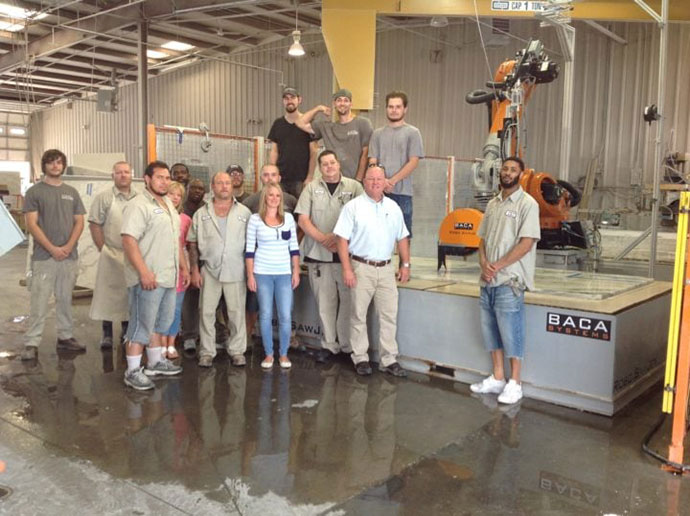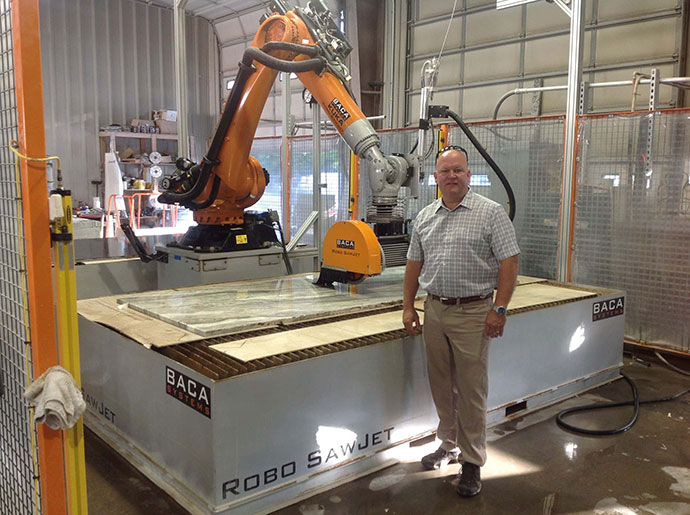
Reinvents Itself Through Robotics
After 81 years, Mees Tile & Marble is reinventing itself through the latest stone fabrication technology.
CEO Todd Meyer is the third generation of his family involved in the business. His son, Clayton, who runs one of the company’s locations, is the fourth. Founded as a tile installation business in 1937 out of Cincinnati, the company started dealing in stone in 1954. “It’s grown from there,” Todd Meyer said.
…Keeping up was my main problem…
Now based in Louisville, Kentucky, Mees Tile & Marble has a second location in Lexington. Over the years, the business has kept growing. In recent years, the shop began hitting a production wall as it raced to meet demand. The shop had been relying on three bridge saws from Sawing Systems for fabrication. “Keeping up was my main problem and producing the right amount of material needed per day,” Meyer said. “I had to have to have somebody pulling the material, somebody needed to lay out the templates on the material, then you needed a helper loading and unloading continually.” Meyer began looking for ways to increase productivity. In 2017, the company invested in a BACA Systems Robo SawJet that combines a high-pressure abrasive waterjet and a 26HP direct-drive saw with a KUKA Robotics industrial robot. The investment began paying off quickly. “It’s enabled us to go after more builders, more commercial projects, and it has sped up our production by 50 percent,” Meyer said. “What it’s done has shifted saw people to polishing people and/or more installers. I’ve been able to increase the installations per day, and I’ve needed to have more polishers per day. It hasn’t technically decreased personnel, but it’s manipulated them to other positions within the company.”
“It’s enabled us to go after more builders, more commercial projects, and it has sped up our production by 50 percent”
Increased Yield and Productivity
It takes just 15 to 18 minutes for a Robo SawJet to cut a standard 40-square-foot kitchen countertop with a sink hole from a slab. It has a dual-table design, meaning there is no need to stop the saw to load or unload slabs.
As one slab is cut, another can be loaded onto the opposing table, radically decreasing production time. “With the sawjet and the vacuum lifts, one man can do approximately three times the amount of fabrication that two or three people can do on a bridge saw,” Meyer said.
The Robo SawJet has become the shop’s dependable workhorse. “It’s producing between 400 and 800 square feet a day, depending on what we need for a given job,” Meyer said. “It hasn’t called in one time. It hasn’t needed a vacation, and it hasn’t been sick one day.”
Robo SawJet customers save an average of 20 percent on material cost annually due to increased yield from slabs. Guided by the BACA Robo SawJet’s onboard software that optimizes cutting patterns, the combination of the direct-drive saw and the waterjet maximizes the amount of usable material from each slab.
“Basically, I’ve decreased the number of remnants that we generate, which is huge in the stone industry,” Meyer said. “We’ve increased our yield substantially. It’s been very good.”
The BACA RoboSawJet’s IDE Diamond Cutting Head offers consistent accuracy. The Mees Tile crew tests the Robo SawJet’s saw and waterjet about every other week, just to check on the alignment of the cutting processes, Meyer said. “It hasn’t made a mistake yet. I’m not sure it’s going to.”
In addition to the Robo SawJet, the Mees shop continues to utilize two of its bridge saws but mainly for simple and straight cuts.

Virtually Maintenance-Free
So far, the Robo SawJet has only required elementary maintenance on its waterjet pump. The KUKA robot itself needs literally no maintenance for 10,000 hours or 5 years. “We have a few issues every now and then with a little leaking seal here or a little leaking seal there, but so far it’s been an easy fix,” Meyer said. “Other than that, it’s been pain-free.”
Originally designed to hold up in 24-hour per day automotive manufacturing environments, the Robot Sawjet’s sturdy H2O jet pump is built to last. It can last about three times longer between rebuilds than Hypertherm pumps. The components are quicker to install and are cheaper than those used in competing brands of waterjet pumps.
“We’ve increased our yield substantially. It’s been very good.”
Easy-to-use Software
The Robo SawJet offers simple, intuitive PC-based operating software. It is designed to enable any employee to be able to operate it without the need for extensive training. It’s simple enough that even the boss can use it, Meyer said. “I use it only when I have to. I have a couple of guys that’s what they do every day. The times I have gone onto it, it’s been fine, and there have been no problems whatsoever. I can find my way around it. I can complete a job.”
Because of the simplicity of the software, Meyer does not have to depend on one or two experienced employees to operate the saw. “I have two people that back up my main operators,” he said. “That way whenever we do have vacations or sick periods with employees, I’ve got backup support within the company.”

Training Process and Customer Service
While BACA Systems was installing the Robo SawJet at the Mees Tile facility, it flew several of the shop’s employees up to the BACA headquarters in Detroit for a thorough training program.
“We sent a couple of fellows up there,” Meyer said. “It was first class. Compared to having little or no training from some other companies, I can’t compare the sawjet from BACA to anything else. The learning curve on the Robo SawJet is nowhere near as significant as for CNC machines.”
BACA also prides itself on stellar customer service. “It’s outstanding,” Meyer said. “We buy from some pretty reputable companies, but their customer service is by far some of the best we’ve dealt with.”

